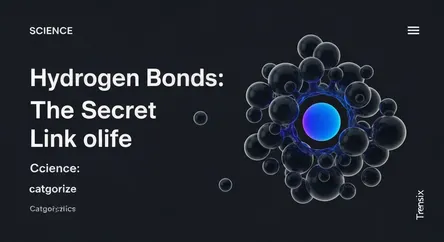Science
Hydrogen Bonds: The Secret Link of Life

Discover the hydrogen bond, a crucial intermolecular force responsible for water's unique properties and the structure of DNA and proteins.
What is it?
A hydrogen bond is a special type of attractive intermolecular force, not a true covalent bond. It forms when a hydrogen atom, already bonded to a highly electronegative atom (like nitrogen, oxygen, or fluorine), is attracted to another electronegative atom nearby. This creates a weak electrostatic link that is stronger than van der Waals forces but weaker than covalent or ionic bonds. These bonds are dynamic, constantly forming and breaking, particularly in liquid water. A classic example is the bonding between water molecules, which gives water its unique characteristics.
Why is it trending?
Hydrogen bonds are a fundamental concept in science, crucial for understanding countless biological and chemical processes. Their study is key to advancements in materials science, drug design, and molecular biology. For instance, they are responsible for holding the two strands of the DNA double helix together, ensuring the stability of genetic information. They also dictate the three-dimensional shapes of proteins, which is vital for their function, including enzyme activity. The unique properties of water, such as its high boiling point and the fact that ice floats, are all consequences of hydrogen bonding.
How does it affect people?
Hydrogen bonds are essential for life itself. Without them, water would be a gas at room temperature, and life as we know it would not exist. They provide the structural integrity for DNA and proteins, the building blocks of our bodies. This molecular interaction also affects everyday materials; it gives strength to polymers like cellulose in paper and plants, and is used in the creation of synthetic materials like nylon. From the water we drink to the very molecules that make up our genetic code, hydrogen bonds are a silent but powerful force shaping our world.